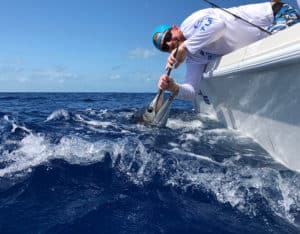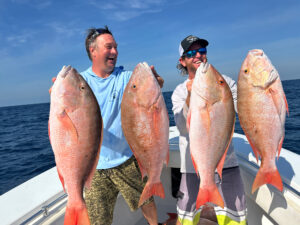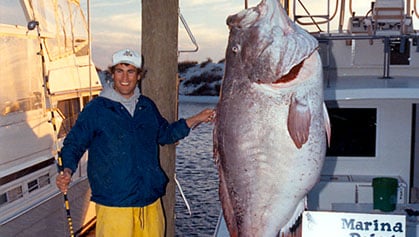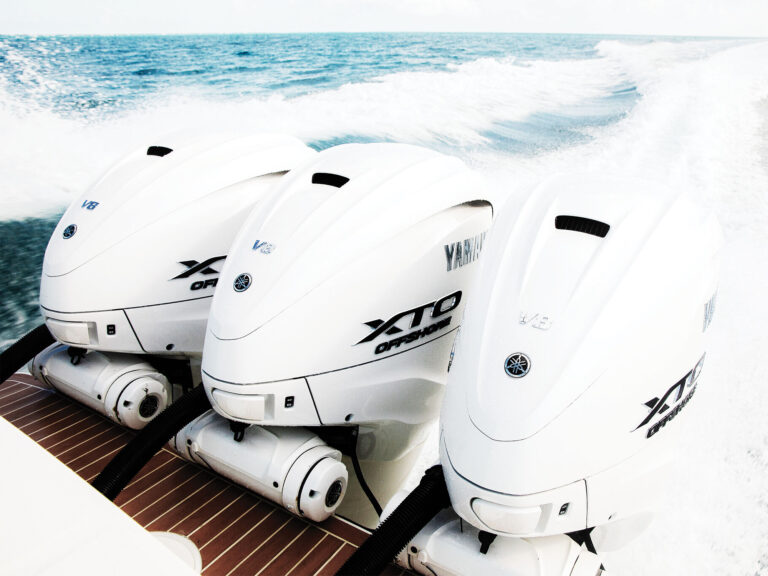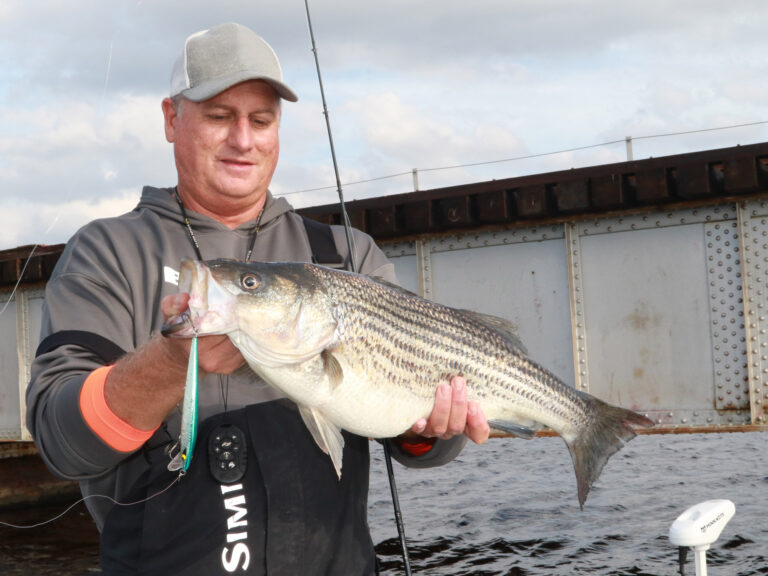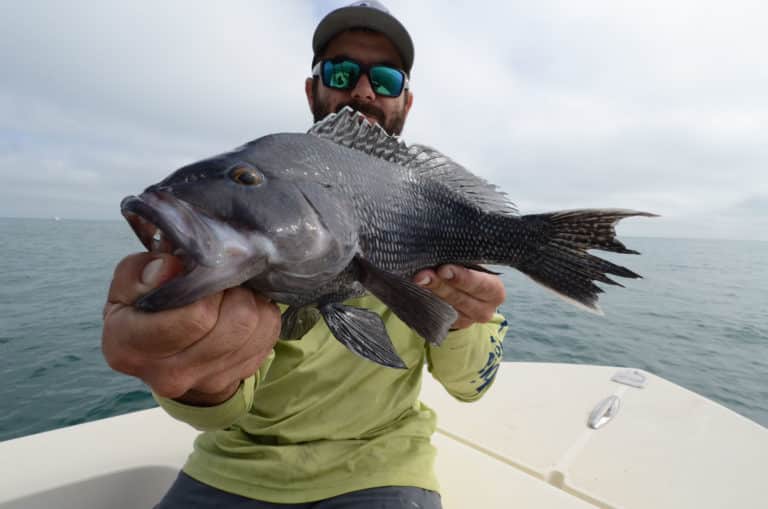Little Guy with a Big Eye
QUESTION:
Have you seen one of these, mate? If so, what is it?
Riley Tolmay, Sydney, Australia
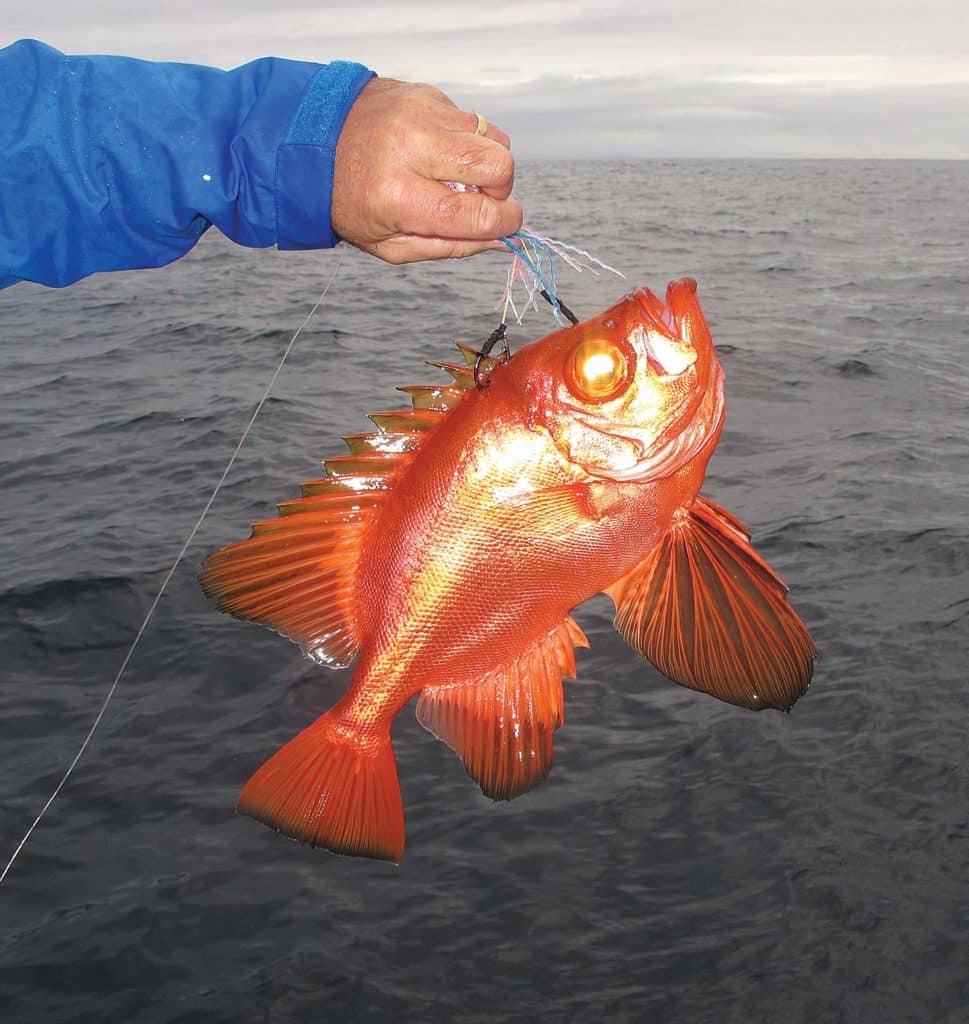
ANSWER:
What you’ve caught there, Riley, is a longfinned bigeye (Cookeolus japonicus), one of the more notable members of the family Priacanthidae (bigeyes). This species occurs worldwide on deep rocky reefs in coastal waters between 120 and 1,200 feet deep. Like other priacanthids, C. japonicus prefers low-light conditions (hence the bigeye’s big eyes) and is commonly found inside caves and holes, usually venturing from these areas only to feed at night. It mainly eats planktonic shrimp, crabs and other small prey, including squid and octopuses. Because of this, it is encountered occasionally by anglers who are lucky enough to put their bait right next to — or into — the hole or ledge in the reef where a bigeye is hiding. In the Caribbean, this species is thought to spawn during the summer months. It’s one of the larger priacanthids, growing to around 28 inches long and 10 or so pounds. You could enter the next one you catch to qualify for the IGFA all-tackle world record as, to date, no one has entered a longfinned
— Ben Diggles
__________________________________________________________________________________
New Guinea Grouper
QUESTION:
We run sport-fishing tours out of the remote rivers in the New Britain province of Papua New Guinea. Besides catching the notorious PNG black bass (our main target), we also catch these interesting grouper on lures while casting at snags or other structure in lower rivers. I’ve always wondered what they are. Some have white dots, and others are just black. Are those the same species? I have caught them more than 2 feet long in the fresh water of rivers from the middle reaches down to the river mouth.
Richard Reimann, Baia Wilderness Fishing Lodge, Papua New Guinea
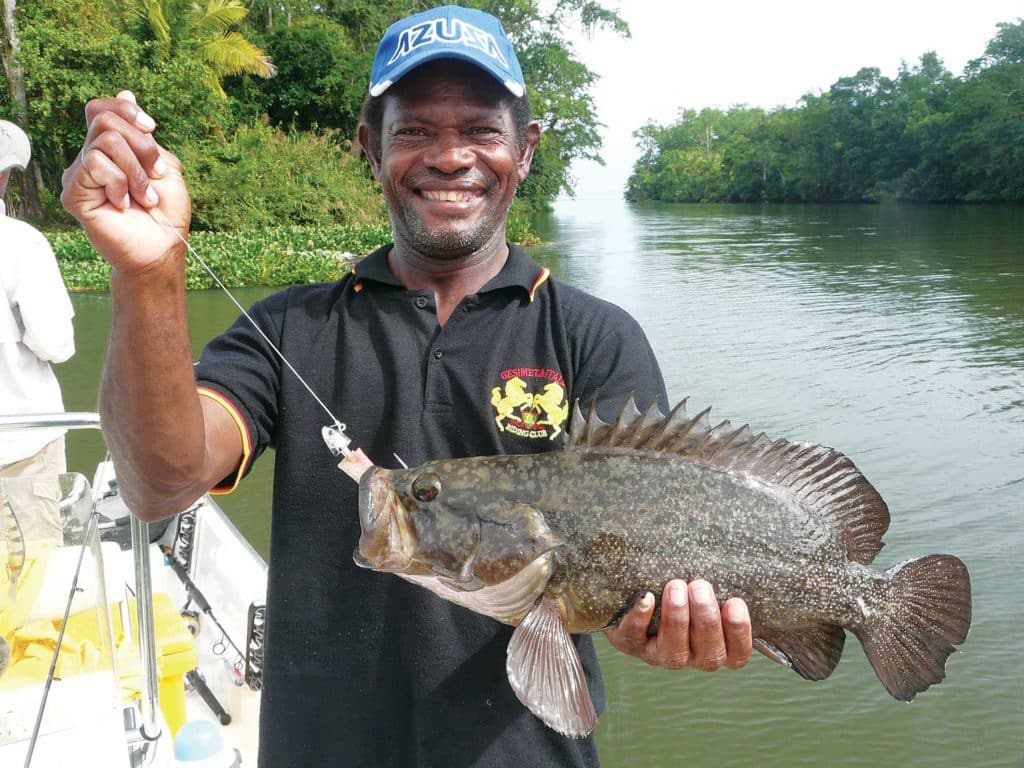
ANSWER:
What you have been catching there, Riccard, are white-dotted grouper (Epinephelus polystigma). Also known as white-spotted rock cod, this species occurs in estuaries and rivers from the Philippines south through eastern Indonesia, PNG and the Solomon Islands to northern Queensland, Australia. It appears to have two main forms, either with white dots or a dark-brown or black blotchy color pattern. In some parts of their range, white-dotted grouper are known by natives as “lazy fish,” easy to spear when they aggregate near mangroves in shallow water at night, resting on the bottom with their backs out of the water. Because of this behavior, the species quickly becomes rare around areas inhabited by humans. E. polystigma is a reasonably small grouper, growing only to 20 inches or so; thus, the biggest ones you have been catching at 24 inches approximate their maximum size, indicating you must be fishing in some remote areas to catch them that big. Scientists know very little about this species, though they’re understood to be solitary usually — the shallow-water aggregations are probably spawning behavior, as they occur mainly on new-moon phases and the fish taken during this time are running ripe. White-dotted grouper sampled between 8 and 15 inches long proved to be mature females, and all fish above 18 inches long were mature males, suggesting that these fish may, like other serranids (groupers), mature first as females before changing sex into males.
— Ben Diggles
__________________________________________________________________________________
Very Long Spine from the Socal Brine
QUESTION:
We were fishing in about 100 feet of water off of San Pedro, California when I caught this cute little guy. Actually snagged him with a stinger-style jig. He didn’t want to lay flat for a picture, but I got one shot before he curled up again. It looks to me like a cross between a lizardfish and a goby. After a nearly a lifetime of fishing SoCal, I’m stumped. What is this?
Peter Corselli, La Habra Heights, California
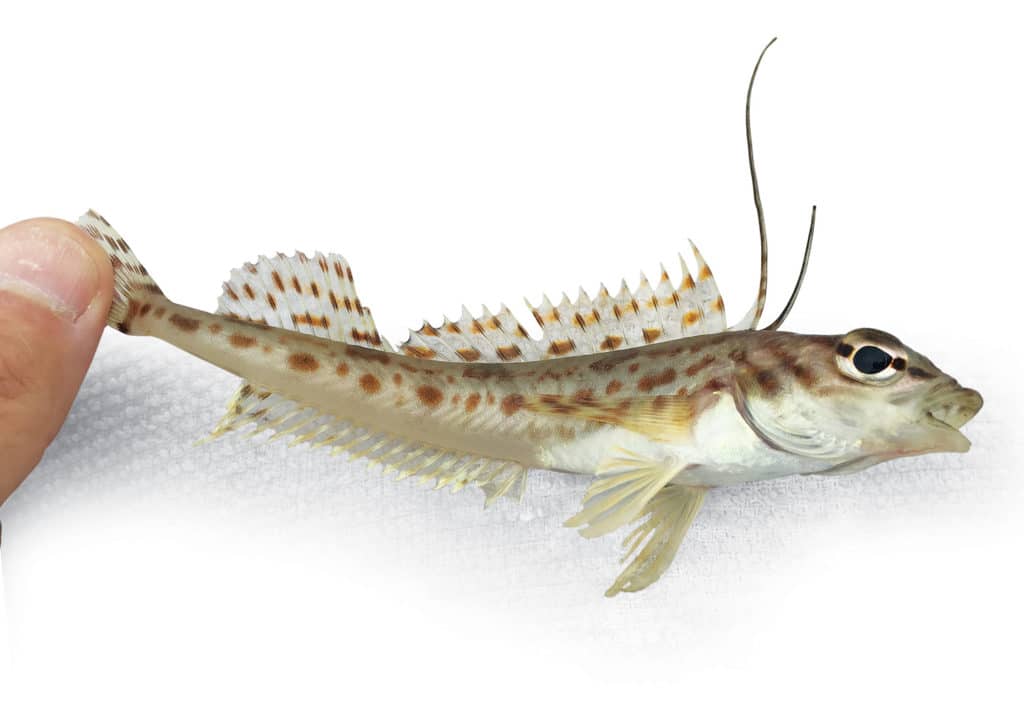
ANSWER:
Peter, that little bitty mouth and those long dorsal spines make this a longspine combfish, Zaniolepis latipinnis — a quite-distant cousin of the toothy lingcod. Longspines are a dwarf species, topping out at about 12 inches long and found along the west coast of North America from Vancouver Island to southern Baja California at depths of about 50 to 1,000 feet. When I conduct fish surveys in manned submarines off California, I usually see longspines on cobble, or occasionally muddy sea floors, often resting right on the bottom (they rise up to feed on krill and the like), and often sitting in a little divot that they likely dig for themselves. This is a short-lived species — a 7-year-old is a veritable Methuselah. By the way, you mention that when you landed your combfish, it curled up; for some reason, every combfish I have ever captured did the same thing, though I have no idea why.
— Milton Love
__________________________________________________________________________________
My Heart Bleeds
QUESTION:
On a Baja Web forum, I posted that an angler should bleed almost every fish he catches. Another poster in the thread challenged me to document my reasoning. Can a fish-facts expert provide evidence for why this practice should be done?
James Hamada, Los Angeles, California

ANSWER:
Contrary to one widely held belief, blood doesn’t normally carry bacteria that would be involved in spoilage — if it did, fish would have chronic infections throughout their lives. However, blood might give fishes’ flesh a strong, “gamy” flavor if it’s allowed to remain in their muscles after death. This is especially true of strongly swimming fishes that have large amounts of highly vascularized red muscle. Thus, in most species, the reason for draining blood is to prevent the blood from altering the taste of a fish’s flesh.
Some fish such as the tunas are heterothermic, meaning that their body temperatures are well above that of the surrounding seawater but still vary as the water temperature varies. The physiological basis for the elevated body temperatures involves the arrangement of blood vessels that allows heat transfer between vessels, allowing more heat to remain inside the fishes’ bodies. In these species, removing the blood allows a fish to cool down more rapidly and helps prevent it from spoiling or “cooking” from its own body-generated heat.
Finally, blood can serve as a growth medium for bacteria, so once it leaves a fish’s circulatory system, it can promote spoilage — especially if a fish isn’t properly cooled. The best way to ensure having the highest-quality bony fish possible for table fare:
- Open the cavity that contains the heart (the pericardial cavity, located in the fleshy space below the back part of a fish’s gill covers) and cut the large vessel coming out of the front of the heart.
- Let the blood drain from the circulatory system.
- Remove the fish’s gills and viscera.
- Lightly rinse the fish in saltwater to remove as much remaining blood as possible. • Then pack the fish in ice.
With tuna, it’s also a good idea to sever the spinal cord behind the head to prevent nerve impulses from reaching the fish’s muscles, which can generate additional heat and help promote spoilage
— Ray Waldner
__________________________________________________________________________________
What Lurks Behind Bars
QUESTION:
An angler fishing with my partner, Capt. Matt Tusa, caught this funny-looking thing while fishing around some structure in Chandeleur Sound, about 20 miles south of Bay St. Louis, Mississippi. The water depth was 10 to 12 feet, and they were fishing with live shrimp on bottom rigs. Over the years, we’ve seen some strange critters come out of these waters, but this one takes the cake. We think it might be some sort of grunt or pigfish? They released the fish unharmed, not knowing the species and not wanting to break any laws. Any ideas?
Capt. Sonny Schindler, Shore Thing Fishing Charters, Bay St. Louis, Mississippi
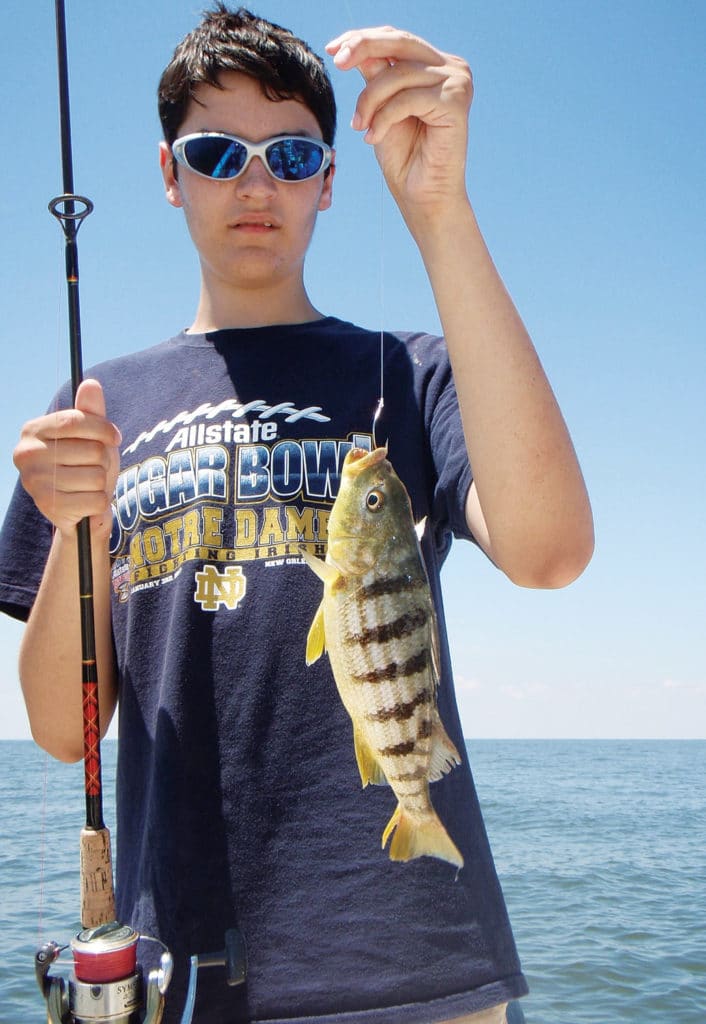
ANSWER:
Well, Sonny, you had us stumped for a while, and in our defense, for good reason. The fish you nailed is a barred grunt, Conodon nobilis. I didn’t suspect this at first because these guys tend to be more tropical, and aren’t known from the northern Gulf. Also, your specimen was unusually vivid in its markings. But a little digging, and some photos of similarly marked specimens from Texas, confirmed the ID. Grunts get their name from the sound they make by grinding the teeth on bones located in the back of the throat called pharyngeal bones. Most grunts are small, topping off at about a foot or so, as with your barred grunt. Although grunts are extremely abundant along most temperate and tropical areas, they are not a prized food fish. Barred grunts are known as far north as Texas, but are most common in the Caribbean and south to Brazil.
— Bob Shipp
__________________________________________________________________________________
Far From Home
QUESTION:
In September, while cast-netting for finger mullet off a New Jersey beach, I noticed this fish in the net as well. It was approximately 4 inches long. Any idea what it is?
Darren Tremmel, Brick, New Jersey

ANSWER:
Darren, this juvenile fish is none other than a Florida pompano, Trachinotus carolinus, family Carangidae (jacks and trevallies). Among the key characters are the detached spines forward of the dorsal and anal fins, and the slightly higher counts of fin rays in those fins. Juveniles of permit (T. falcatus) are similar, but have fewer fin rays. I assume you were cast-netting in the surf zone off New Jersey; that’s a habitat where juvenile pompano are not uncommon. The species spawns off the coast of the U.S. Southeast, but young stages of several carangid species drift north as they develop, and find themselves in agitated surf-zone waters off sandy beaches, such as those found along the New Jersey coast. Some of these southern “waifs” find themselves stranded so far north with the onset of cooler waters in the fall that they might not survive the winter. Others, however, use these surf-zone habitats as nurseries and, after a season of growth, are able to migrate back to coastal waters south of Cape Hatteras, where they rejoin members of their year class
— Mike Fahay
__________________________________________________________________________________
Snared a Drum
QUESTION:
I caught this guy in the Indian River Lagoon near Fort Pierce, Florida, while fishing for live baits. I’m guessing it’s a silver seatrout or a white perch. What does the expert say?
Capt. Tim Simos, Bluewater Inshore Guide Service, Fort Pierce, Florida
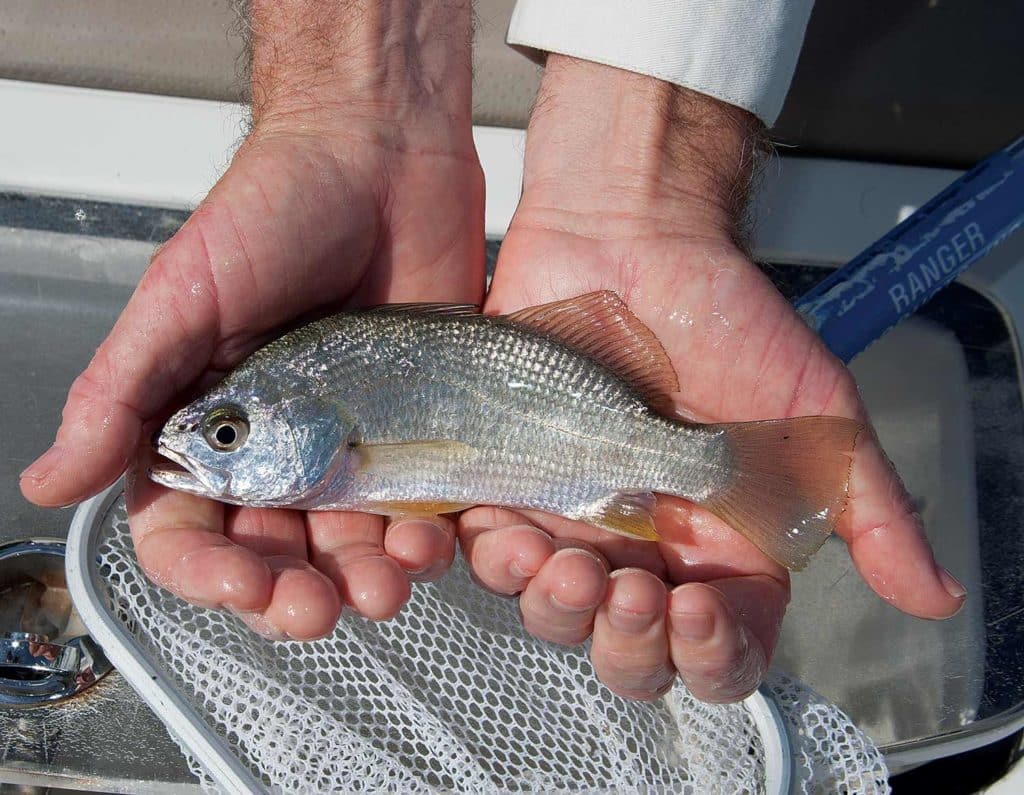
ANSWER:
Nice photo as usual, Tim. Your catch is a silver perch, Bairdiella chrysoura. This member of the drum family ranges from New York to South Florida, as well as portions of the Gulf of Mexico south to Mexico. It’s commonly found in coastal areas over sandy, muddy and grassy bottoms, and is even known to enter fresh water. Most commonly used as bait, silver perch are purportedly excellent eating. However, their small size — usually well under 12 inches — prevents a single individual from providing much in the way of nourishment!
— Ray Waldner

